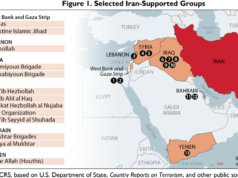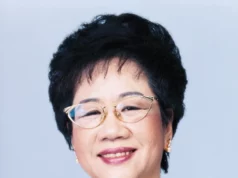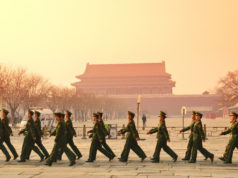In 2014, students and activists in Taiwan and Hong Kong took to the streets to mount sustained and vigorous challenges to official government policies. What was the nature of youth participation in these demonstrations? How are the demonstrations affecting not only their respective societies, but also the future of youth activism?
The Taiwan Sunflower Movement
In June 2013, Taiwan and China signed the Cross-Strait Agreement on Trade in Services, greatly reducing barriers to trade and travel. Taiwanese President Ma Ying-jeou argued that the pact would help liberalize Taiwan’s economy, facilitate Taiwan’s participation in more regional trade talks, and strengthen ties between Taiwan and China. Yet, the agreement proved extremely controversial in Taiwan. On March 18, 2014, hundreds of university students and civil society activists, supported by as many as ten thousand Taiwanese in the streets, peacefully occupied the Taiwan Legislative Yuan to protest the “black box negotiations,” sparking the Sunflower Movement. When another unarmed group attempted to protest inside Taiwan’s Cabinet, or Executive Yuan, a few days later, riot police beat and assaulted them with water cannons and pepper spray, evoking memories of the martial law era. British academic Gary Rawnsley argued the attacks on demonstrators led observers “to question the government’s values and principles that underpin Taiwan’s soft power capacity.”
Painting the student protestors as anti-China or anti-free trade is misleading and overly simplistic. Their discontent was rooted primarily in the government’s perceived failure to negotiate the bilateral trade pact fairly and transparently, or consider public anxieties regarding its potential impact. Demonstration leaders called upon the government to nullify the agreement, establish a legislative mechanism to oversee future cross-Strait pacts, and hold a national public dialogue on the issue. The young protesters emphasized that they were not against trade with China, but rather wanted to ensure that bilateral trade did not cause Taiwan to grow politically and economically dependent on the PRC, diminish Taiwan’s sovereignty, damage national security, or erode Taiwan’s hard-won democratic rights and liberties.
The Hong Kong Umbrella Movement
Hong Kong’s Umbrella Movement began with a January 2013 article. Frustrated by a lack of true political autonomy, University of Hong Kong constitutional law professor Benny Tai exhorted the populace to use civil disobedience as a means of reinvigorating the democracy movement. Along with sociology professor Chan Kin-Man and Rev. Chu Yiu-Ming, he created Occupy Central with Love and Peace (OCLP) and called upon people to occupy Hong Kong’s business and financial district.
Over the next year, OCLP participants deliberated and eventually decided to submit for public debate three referenda, all of which embraced the idea of civil nomination of candidates for Hong Kong chief executive. In response to demands for universal suffrage, Beijing released the White Paper on the Practice of “One Country, Two Systems” Policy in the Hong Kong Special Administrative Region [HKSAR] in June 2014. Chinese authorities stated, “the high degree of autonomy of HKSAR is not an inherent power, but one that comes solely from the authorization by the central leadership. The high degree of autonomy of the HKSAR is not full autonomy, nor a decentralized power. It is the power to run local affairs as authorized by the central leadership.” Beijing made it clear no candidate could assume the role of chief executive without its approval, dashing hopes that it would tolerate an open and democratic nomination process or real universal suffrage.
The controversial White Paper caused a public outcry. Nearly 800,000 people—20 percent of the Hong Kong electorate—subsequently participated in the unofficial civic referendum during polling from June 20-29, 2014. The winning “three-track” proposal suggested that an official nominating committee, the Legislative Council, and members of the public could all put forward candidates for chief executive. Participants also voted overwhelmingly that the legislature should reject any government attempts at electoral reform that failed to meet international standards. Beijing immediately rejected OCLP’s proposal.
OCLP democracy activists initially planned to launch the civil disobedience movement on October 1st, the symbolically significant National Day of the People’s Republic of China. However, the Hong Kong Federation of Students and Scholarism, university and secondary students, respectively, preemptively organized strikes to protest Beijing’s decision. They subsequently marched on the government headquarters on September 27th. As in Taiwan, the sight of riot police assaulting students galvanized public opinion and attracted a great deal of sympathy for the demonstrators.
Tens of thousands of citizens occupied major roads in Central and spread to other locations on both sides of Victoria Harbor, including Admiralty, Causeway Bay, and Mong Kok. Volunteers donated food and water, students worked on their mathematics homework on the streets, and a sea of tents was a common sight in one of the world’s most powerful financial centers. Beijing continued to declare its support for Hong Kong Chief Executive C.Y. Leung, even as protesters called for his resignation. After 75 days, police cleared the Umbrella Movement’s main encampment and arrested prominent activists on December 11th.
Youth Political Participation in Taiwan and Hong Kong
Although unsuccessful in its initial goals, the Sunflower Movement has inspired secondary school students to take a greater interest in political and social movements in Taiwan. A senior surnamed Wang argued that, as a result of the student-led movement, new NGOs and independent media networks have allowed more senior high school students to access information and resources. “The whole societal atmosphere has changed,” as the student movement has challenged the prevailing mainstream values and facilitated greater dialogue in classrooms. For example, high school students have grown deeply involved in an online campaign to oppose proposed changes to the national educational curriculum. A junior surnamed Gu agrees, arguing that more high school students understand how to use the media and the Internet to apply public pressure. The Sunflower Movement, Gu argues, has thus encouraged young Taiwanese who are passionate about social change to stand up for their beliefs and put their ideas into action.
Taiwanese high school students played an active supporting role in the Sunflower Movement. University and graduate students even offered free on-site tutoring to those high school students who came to support the demonstrations. However, when asked why their peers in Hong Kong seemed to appear in greater numbers and take a greater leading role in the Umbrella Movement, Gu suggested that some young Taiwanese are still, first and foremost, struggling with their own identity. What is their ethnicity and nationality? Are they Taiwanese or Chinese? When students pose such “sensitive” questions, teachers will often smile but avoid discussion of the issue. If we ask other adults, she says, they will begin discussing the issue of unification versus independence, which serves only to make us perplexed and unsure of our own identity. She adds that it was the impending sense of crisis that drove large numbers of students in Hong Kong to join the Umbrella Movement.
Too many Taiwanese youth still feel indifferent toward social issues. At an age when students are still grappling with their own identity and how to fit in, she argues, it is easy for students to derisively label those who show interest in such issues as social movement activists and perhaps even brush them off. Students might think you’re an independence activist, Gu remarks, in which case you’ll also encounter opposition from China. She appears to believe that after encountering resistance and societal pressure, some students simply shrug their shoulders and ask what they could possibly achieve as mere students. Yet, while she is concerned about students who give up on ideas so easily, increasing student activism, particularly by secondary school students during the Sunflower Movement, heartens her.
Gary Cheung, a young secondary student in Hong Kong, played an extremely active role in the Umbrella Movement. The police arrested him and tried to interrogate him without an adult or lawyer present. As a looming injunction required him to face a judge prior to returning to the protests in Mong Kok, a public defender attempted to “convince” Cheung to enter into a plea deal. Authorities also threatened to remove him from his parents’ custody. In fact, in at least a few cases, authorities wished to wrest guardianship of young protesters from their families. HKSAR Chief Executive C.Y. Leung warned students to “think about the consequences of joining the occupation, which is an illegal movement.” Gary Cheung argued that teachers are now under pressure to denounce democracy in the classroom and no longer teach about the Tian’anmen Massacre. Like Gu, he lamented that, despite secondary school participation in the Umbrella Movement, not enough young students care about the fate of Hong Kong.
Maya Wang, a researcher at Human Rights Watch in Hong Kong, nevertheless emphasizes that youth in both Hong Kong and Taiwan are succeeding in challenging cultural and societal norms. Many observers have argued that the existence of a traditional Confucian educational system and societal structure has historically meant that young people are meant to respect their elders, teachers, and leaders without question. However, during the Sunflower and Umbrella movements, young people have begun to question established norms, demand change, and repudiate traditional wisdom. They are asking, what do we want in life? What should the future hold? It is about the pursuit of democracy, but is also about rejecting traditional values and rejecting the idea that one should “just keep his head down.” Wang argues that young people in Hong Kong “are daring to challenge the government as part of the spirit of this new era,” a sentiment that applies to Taiwan as well.
The future of social activism in Taiwan and Hong Kong?
When young Taiwanese activists occupied the Legislative Yuan, they made a conscious decision to avoid any overt alliances with political parties. Many Democratic Progressive Party political leaders were nonetheless supportive of their agenda and the center-left party has the most to gain from courting those who participated in the Sunflower Movement. Dr. Ketty Chen, Director of Research of the Taiwan Association of Public Issues Studies, believes the DPP is focusing upon gaining the support of this new generation of “social movement activists,” some of whom have already entered into the political arena ahead of the 2016 elections. In a June 2015 speech in New York, DPP Chairwoman and 2016 presidential candidate Tsai Ing-wen said that through engagement “with civil society and the ‘Third Force’ [small political parties formed by Sunflower Movement participants], we hope to build a flexible cooperative relationship, and we will not ignore any possibilities…. we can then incorporate Taiwan’s multifaceted and pluralistic values on the vessel that is the DPP.”
The most important challenge currently facing Sunflower activists, argues Dr. Chen, is how “they transform themselves from social movement activists to participants in politics.” The political game is very different than protesting in the street. The “political arena” requires “compromises, bargaining, negotiating, and balancing.” Various groups of activists have splintered off to create new political parties, such as the Social Democratic Party and the New Power Party that must contend with the DPP and KMT, the latter of which is particularly “entrenched at the grassroots level.” The inability of the activists to unify and work together ultimately hurts their cause. Dr. Chen asserts, “Despite the dwindling popularity of President Ma, factors of ideological rigidity” as well as a “lack of funds and staff” have hitherto “contributed to the Third Force remaining a fringe entity in Taiwanese politics.”
Ian Rowen is a University of Colorado graduate student who conducted research during the Sunflower and Umbrella movements as a participant observer. He expects greater moderation and little radical street action from Taiwan Sunflower movement participants because they can channel their energy through the political process. In Hong Kong, where activists lack proper outlets to channel their ideas for democratic reform, instability remains more likely. Nationalist forces continue to grow despite an abiding sense of political fatalism among many long-time residents. Perhaps for the first time since the Tian’anmen Massacre, Hong Kong has experienced a massive political awakening. The dramatic cultural changes underway may ultimately prove transformative and have implications for the future of Hong Kong society beyond the issues of political reform and universal suffrage. “The discussion of politics is no longer taboo,” remarked Maya Wang. “No amount of [Chinese] propaganda will be able to turn the clock back.”
One important question regarding the fate of Hong Kong is whether its unique status as a PRC “Special Administrative Region” will change. Hong Kong’s Basic Law states, “The socialist system and policies shall not be practiced in the Hong Kong Special Administrative Region, and the previous capitalist system and way of life shall remain unchanged for 50 years.” Joshua Wong, prominent secondary school student activist and co-founder of Scholarism, told CNN on June 17, 2015 that the fight for democracy is not only about universal suffrage, but also about gaining the right to hold a referendum on Hong Kong’s future after 2047. Activists know that this battle will prove far from easy and will need to continue to shape Hong Kong’s culture and public discourse in the coming years.
Although the proximate causes behind Hong Kong’s Umbrella Movement and Taiwan’s Sunflower Movement are undoubtedly different, demonstrators in both locales have ultimately demanded that leaders be held accountable to the populace. If they succeed in bringing sustainable political, economic, and social reforms to Hong Kong and Taiwan, then they shall also succeed in teaching the rest of the world about the enduring value and relevance of deepening civic discourse and democratic development.
Julia Famularo is a Smith Richardson Foundation predoctoral fellow at Yale University and a doctoral candidate in modern East and Central Asia political history at Georgetown University.





